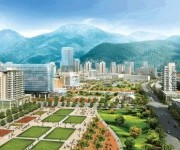 More livable? A vision for Chengdu Xiqi town center.Courtesy IMC OctaveFew countries are urbanizing as rapidly as China, and all that growth has placed tremendous strain on existing cities. There are 171 cities in China that currently have more than 1 million inhabitants, and that number is expected to rise to 219 by 2025. Such drastic growth requires building at a frenetic pace. The result, for the most part, has been block after block of apartment towers, most of which appear to lack any soul or connection with Chinese architectural heritage.
More livable? A vision for Chengdu Xiqi town center.Courtesy IMC OctaveFew countries are urbanizing as rapidly as China, and all that growth has placed tremendous strain on existing cities. There are 171 cities in China that currently have more than 1 million inhabitants, and that number is expected to rise to 219 by 2025. Such drastic growth requires building at a frenetic pace. The result, for the most part, has been block after block of apartment towers, most of which appear to lack any soul or connection with Chinese architectural heritage.
Enter two brothers, Calvin and Frederick Tsao, architect and developer respectively. Calvin is a partner at Tsao & McKown, based in New York City, and Frederick is director of the IMC group, a shipping company-cum-conglomerate that has a few of its fingers in China’s booming real estate market. They have been given a unique opportunity to shape China’s urban future.
From The Architect’s Newspaper:
Approached for years to design projects in China, the brothers were disheartened by the commercial objectives of prospective developers. “We felt design should serve a higher purpose, especially in China,” said Calvin Tsao, who also teaches frequently at Harvard’s Graduate School of Design. Octave’s stated mission — to develop an environment that “balances agrarian and urban societies” — responds to a perceived “malaise and anxiety” resulting from China’s rapid urban growth as it cuts large portions of the population off from its rural past without cohesive alternate planning strategies.
The Tsao brothers have teamed up to imbue Chinese cities with some mixed-use pedestrian friendliness. The idea is to retain some of the connections to the existing rural landscape to ease people into city living. Their two Chengdu plans are heavy on parks and plazas to encourage walking and socializing. Encouraging exercise for new urban denizens is probably a good thing — obesity rates in rural China are only 5 percent, but the rate in cities is four times higher [PDF].
This being China, the Tsao’s plans are still heavy on austere high-rises. While this could hamper that friendly neighborhood feel they’re going for, the biggest challenge will be combating a malady that affects many planned communities — the utter lack of spontaneity. Planned cities and neighborhoods often feel, well, fake.
The Tsao brothers are on the right path in trying to connect new developments with China’s older villages. It also bodes well that the Chinese government has supported them so far. But these projects are a drop in the bucket compared to the tremendous number of new buildings Chinese cities will have to add in the coming decades. Doing it right costs money, and China’s epic growth streak will have to come to an end at that point. Hopefully some of the Tsao’s ideas will have taken root by then.



